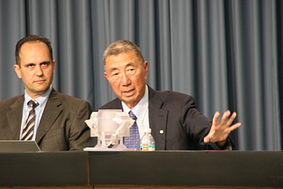Samuel Ting
 | |
| Data i miejsce urodzenia | 27 stycznia 1936 Ann Arbor |
|---|---|
| Zawód, zajęcie | fizyk |
| Strona internetowa | |
| Ten artykuł od 2014-02 wymaga uzupełnienia informacji. |
Samuel Chao Chung Ting (chiń. 丁肇中; pinyin Dīng Zhàozhōng; ur. 27 stycznia 1936 w Ann Arbor) – amerykański fizyk pochodzenia chińskiego, profesor MIT, laureat Nagrody Nobla w dziedzinie fizyki za odkrycie cząstki elementarnej J/ψ[1][2].
Życiorys
Jego rodzice pochodzili z Rizhao w prowincji Szantung, ale Ting urodził się w Michigan, gdzie studiowali. Wkrótce wrócili do Chin. Podróże te spowodowały, że wczesna edukacja Tinga była nieregularna i sporadyczna, w dużym stopniu miała charakter edukacji domowej. Jako 20-latek ponownie przyjechał do USA, gdzie studiował inżynierię, matematykę i fizykę na Uniwersytecie Michigan. W roku 1963 uzyskał stopień doktora fizyki[1][2].
Nagrodę Nobla otrzymał w roku 1976 wraz z Burtonem Richterem za ich niezależnie dokonane odkrycie ważnej podstawowej cząstki elementarnej, później nazwanej J/ψ[1][2].
Przypisy
- ↑ a b c Samuel C.C. Ting - Factsv (ang.). W: The Nobel Prize in Physics 1976 > Burton Richter, Samuel C.C. Ting [on-line]. Nobel Media AB. [dostęp 2014-02-06]., Biographical, Nobel Lecture, December 11, 1976, The Discovery of the J Particle: A Personal Recollection
- ↑ a b c Samuel C.C. Ting Bio (ang.). W: Becoming American : The Chinese Experience [on-line]. Public Broadcasting Service (PBS). [dostęp 2014-02-06].
A. Prof. Sa.C.C. Ting w Space Station Processing Facility,
B. Briefing w Kennedy Space Center (28 kwietnia 2011)
Media użyte na tej stronie
Icon of articles which need more text
Autor: Toastforbrekkie, Licencja: CC BY-SA 3.0
A photo of Nobel laureate Dr. Samuel C. C. Ting taken on October 19, 2010 after a presentation he made on the Alpha Magnetic Spectrometer to employees at the Kennedy Space Center in Florida.
Nobel laureate Professor Samuel C. C. Ting of the Massachusetts Institute of Technology pauses for a photo in the Space Station Processing Facility.
- Dr. Ting is directing an experiment, an international collaboration of some 37 universities and laboratories, using a state-of-the-art particle physics detector called the Alpha Magnetic Spectrometer (AMS), which will fly on a future launch to the International Space Station. Using the unique environment of space, the AMS will study the properties and origin of cosmic particles and nuclei including antimatter and dark matter. AMS flew initially as a Space Shuttle payload on the June 1998 mission STS-91 that provided the investigating team with data on background sources and verified the detector's performance under actual space flight conditions. The detector's second space flight is scheduled to be launched on mission UF-4 October 2003 for installation on the Space Station as an attached payload. Current plans call for operating the detector for three years before it is returned to Earth on the Shuttle. Using the Space Station offers the science team the opportunity to conduct the long-duration research above the Earth's atmosphere necessary to collect sufficient data required to accomplish the science objectives.
Alfred Nobel from public domain photo, in circle. (Photo taken 1896 or earlier).
Autor: DLR German Aerospace Center, Licencja: CC BY 2.0
Samuel Ting, AMS-02 Principal Investigator, at the ISS Science & Technology briefing on 28 April 2011 at NASA Kennedy Space Center.






